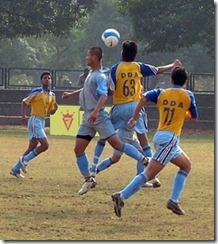1 person scorched to death in field
MEHEDI HEDAYTULLAH

Chanabana (Bihar), Sep 29 : Fifteen tankers loaded with fuel were gutted and more than 10 lakh litres of diesel burnt when a goods train carrying them jumped tracks in Chanabana on the Bihar-Bengal border this morning.
Chanabana is 5km from North Dinajpur’s Islampur or Aluabari Road station and 65km from New Jalpaiguri, the railway’s gateway to the Northeast.
The inferno caused the tracks to melt, leading to disruption in train services on the Aluabari-NJP route. At least three Up trains from Calcutta — the Darjeeling Mail, Padatik and Kanchankanya — were held up for more than four to five hours along the route.
The heat from the burning fuel also scorched to death a villager, whose body was found after the flames were doused. Paddy on 500 acres along the tracks have been burnt.
The Northeast Frontier Railway (NFR) said the goods train, with 51 tankers and each of them filled with 70,000 litres of diesel from the Numaligarh Refineries Limited, was on its way to Jamshedpur from Maligaon in Assam.
Around 7am, when the train was crossing Chanabana village, two tankers jumped tracks, sparking a fire that almost enveloped the train. The NFR suspects that friction between the tankers that jumped tracks might have led to the fire.
When the driver realised that two wagons had derailed and were on fire, he and the on-duty guard immediately severed most of the tankers from the front and rear of the train, thus saving 36 containers.
Soon, three tankers, which were on flames, jumped fell into a stream. The train had stopped on a culvert over a stream.
Twelve fire engines from Islampur, Matigara, Siliguri, NJP and Bihar’s Kishanganj were pressed into service within half an hour. But the flames seemed to rise up high with the spraying of water. At the same time, water acted as a coolant for the soil near the tankers, preventing the spreading of the flames. Finally, foam brought from NJP helped douse the blaze around 3.30pm. Udaynarayan Adhikari, the deputy director of the state fire services of north Bengal, said: “Foam helps largely in cutting off oxygen. If water is used, it only acts as a coolant but does not douse the flames as it floats over oil.”
Rafiq Alam, whose house is near the tracks, said when the tankers blew up, he thought there was a train accident.
“There was a deafening sound and we thought there was a train accident. But soon, there was a huge ball of fire, which turned out to be a devastating one,” said Rafiq. “We ran out of our huts. We have never seen this sort of fire before and didn’t know what to do. The paddy fields along the tracks have been damaged.”
Senior railway officials from Katihar and NJP visited the spot. “Based on preliminary investigation, we can say that the fire occurred because of friction after the derailment. The incident led to disruption in rail movement across parts of north Bengal and the entire Northeast,” said B.L. Patil, the divisional railway manager of Katihar. The Chanabana area comes under the Katihar division of the NFR. “A good number of tankers could be saved because of the promptness of the driver and guard.”
The engine of the goods train took away some of the tankers to Aluabari Road. Tankers severed from the rear were taken to NJP by another engine that had arrived.

S. Pahan, the superintendent of railway police of Katihar, however, said sabotage was not being ruled out. “We will initiate investigation and cannot comment on the cause of the incident now. Whether it is an incident of sabotage or an accident because of technical faults, is subject to investigation,” he said.
The NFR authorities said though there are two tracks at Chanabana, both have bent and melted because of the heat over a 500-metre stretch and needed to be replaced. “It would take at least a day to repair the tracks and make the service normal,” an official said.
The villagers had been worried about Motiur Rehman, whose body was found later in the day, since the fire started. They said the 44-year-old, who was working in his field along the tracks, was missing since the tankers caught fire. After the flames were doused, Motiur’s charred body was found in the paddy field. The body was sent for post-mortem.







 1.
1. 








